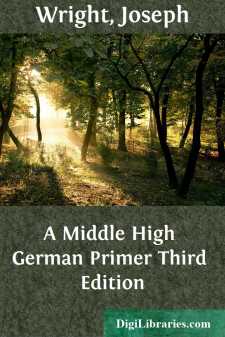Categories
- Antiques & Collectibles 13
- Architecture 36
- Art 48
- Bibles 22
- Biography & Autobiography 813
- Body, Mind & Spirit 142
- Business & Economics 28
- Children's Books 17
- Children's Fiction 14
- Computers 4
- Cooking 94
- Crafts & Hobbies 4
- Drama 346
- Education 46
- Family & Relationships 57
- Fiction 11829
- Games 19
- Gardening 17
- Health & Fitness 34
- History 1377
- House & Home 1
- Humor 147
- Juvenile Fiction 1873
- Juvenile Nonfiction 202
- Language Arts & Disciplines 88
- Law 16
- Literary Collections 686
- Literary Criticism 179
- Mathematics 13
- Medical 41
- Music 40
- Nature 179
- Non-Classifiable 1768
- Performing Arts 7
- Periodicals 1453
- Philosophy 64
- Photography 2
- Poetry 896
- Political Science 203
- Psychology 42
- Reference 154
- Religion 513
- Science 126
- Self-Help 84
- Social Science 81
- Sports & Recreation 34
- Study Aids 3
- Technology & Engineering 59
- Transportation 23
- Travel 463
- True Crime 29
A Middle High German Primer Third Edition
by: Joseph Wright
Categories:
Description:
Excerpt
INTRODUCTION
§ 1.
MIDDLE HIGH GERMAN
Middle High German (MHG.) embraces the High German language from about the year 1100 to 1500. It is divided into three great dialect-groups: Upper German, Franconian, and East Middle German.
1. Upper German is divided into: (a) Alemanic, embracing High Alemanic (Switzerland), and Low Alemanic (South Baden, Swabia, and Alsace). (b) Bavarian, extending over Bavaria and those parts of Austria where German is spoken.
2. Franconian (West Middle German), which is subdivided into Upper Franconian and Middle Franconian. Upper Franconian consists of East Franconian (the old duchy of Francia Orientalis) and Rhenish Franconian (the old province of Francia Rhinensis), Middle Franconian extending over the district along the banks of the Moselle and of the Rhine from Coblence to Düsseldorf.
3. East Middle German, extending over: Thuringia, Upper Saxony, and Silesia.
Since it is impossible to deal with all these dialects in an elementary book like the present, we shall confine ourselves almost exclusively to Upper German, and shall only deal with that period of Middle High German which extends from about 1200 to 1300.
PHONOLOGY
CHAPTER I
THE VOWELS
§ 2. MHG. had the following simple vowels and diphthongs:—
Short vowelsa,ä,ë,e,i,o,u,ö,ü.Long vowelsÃÂ,æ,Ãâ,ë,à Â,à «,œ,iu.Diphthongsei,ie,ou,uo,öu (eu), üe.Note.— ë represents primitive Germanic e (= Gr. ε, Lat. e, as in Gr. δá½³κα, Lat. decem, MHG. zëhen, ten) and is generally written ë in Old and Middle High German grammars, in order to distinguish it from the OHG. umlaut-e (). The former was an open sound like the e in English bed, whereas the latter was a close sound like the é in French été. ä was a very open sound nearly like the a in English hat, and arose in MHG. from the i-umlaut of a (). Good MHG. poets do not rhyme Germanic ë with the umlaut-e, and the distinction between the two sounds is still preserved in many NHG. dialects. In like manner the modern Bavarian and Austrian dialects still distinguish between ä and ë. In the MHG. period ä, ë, and e were kept apart in Bavarian, but in Alemanic and Middle German ä and ë seem to have fallen together in ë or possibly ä, as the two sounds frequently rhyme with each other in good poets. MHG. texts do not always preserve in writing the distinction between the old umlaut-e and the MHG. umlaut-ä, both being often written e in the same text.
Pronunciation of the Vowels.
§ 3. The approximate pronunciation of the above vowels and diphthongs was as follows:—
aas in NHG. mannman,man.Ä„Engl. fatherhÃÂt,has.ä„„„manmähte,powers.æ„„„airlære,empty.ë„„„menhëlfen,to help.e„„Fr.étégeste,guests.Ãâ„„NHG. rehsÃâ,sea.i„„Engl. bitbiten,to beg.ë„„„weenwën,wine.o„„„potgolt,gold.à „„NHG. tottà Ât,dead.u„„Engl. putguldën,golden.à «„„„foohà «s,house.ö„„NHG....

